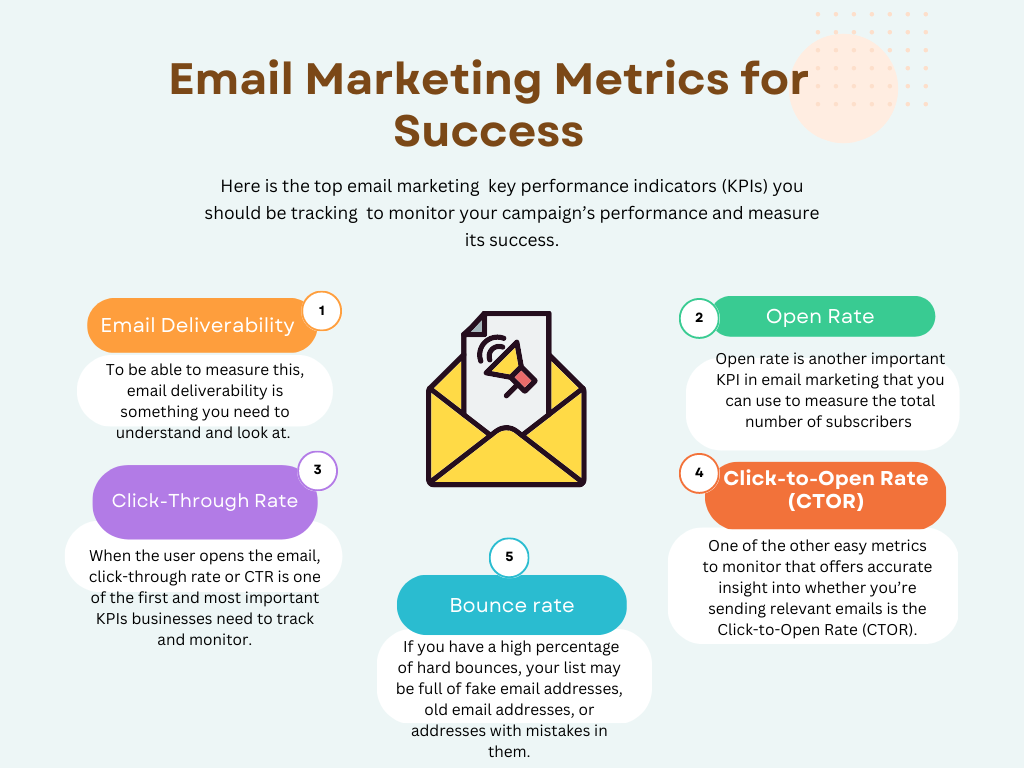Top Email Marketing Metrics to Measure Success
Email Marketing Metrics for Success: CTRs, CTORs, Open Rates
Regardless of the industry and size, email marketing is one of the most powerful tools for businesses. It can be a simple yet effective way for brands to actively engage with their subscribers or target segments.

Data also supports this, with a recent study suggesting that the ROI of a decent email marketing campaign is almost 4 times higher than other marketing channels, which on average is a whopping 122%.
However, mastering the art of email marketing is no easy feat. It can take a lot of time to get the hang of and to keep up with the best practices.
The most important aspect is to define how to measure the success of your campaign even before you begin to outline your overall email marketing strategy.
In this post, we will discuss a few of the top email marketing success metrics or key performance indicators (KPIs) you should be tracking in 2022 to monitor your campaign’s performance and measure its success.
1. Email Deliverability
The very first thing you need to know about the success of your email marketing campaign is whether your emails are reaching or being delivered to your target audience or not.
To be able to measure this, email deliverability is something you need to understand and look at. The email deliverability rate is the metric that helps you learn the percentage of emails that reach or deliver successfully to your subscriber’s inboxes.
How to calculate:
Email Deliverability Rate = (Number of delivered emails) ÷ (Total number of emails sent)
To ensure a high email deliverability rate, monitoring various other metrics, such as a high unsubscribe rate, high bounce rate, and overall sender reputation score, is important.
2. Open Rate
Open rate is another important KPI in email marketing that you can use to measure the total number of subscribers or customers that are actively engaging with your emails.
Open rate here refers to the number of emails the recipient opens against the total number of emails sent by you. A good email open rate ranges anywhere between 17-28%, depending on the industry you’re in.
How to calculate:
Email open rate= (number of emails opened / number of total recipients) x100
Email open rates are also a metric to understand and track when you wish to measure the effectiveness of the subject line and preview the text of your emails.
If your subscribers don’t find your subject line engaging and enticing enough, the chances of them opening your emails are quite low. If they aren’t opening the email, the rest of the KPIs will soon become ineffective.
Some of the best ways to increase the email open rate include personalizing the subject line with the recipient’s name or testing out the addition of emojis combined with your copy.
3. Click-Through Rate
When the user opens the email, click-through rate or CTR is one of the first and most important KPIs businesses need to track and monitor.
CTR indicates whether or not the email content you’re sending is compelling enough and if the same resonates with your target audience.
A good click-through rate should be between 2-5%, depending on the industry you’re in.
How to calculate:
Click-through Rate: (Total clicks OR unique clicks ÷ Number of delivered emails) x 100
If you notice a very low email click-through rate, it usually indicates that the subscribers or the target audience who were once excited to open your email either found something different than they were expecting or didn’t find your offer enticing enough.
4. Click-to-Open Rate (CTOR)
One of the other easy metrics to monitor that offers accurate insight into whether you’re sending relevant emails is the Click-to-Open Rate (CTOR).
The best way to understand CTOR is to think of subscribers who opened your email and what percent of those subscribers found the email content inside relevant enough to click on.
A good email CTOR can range anywhere between 20% and 30%. However, as with any KPI or metric, it’s important to know how you compare with your industry average.
How to calculate:
CTOR= (Unique clicks/Unique opens) x 100
When it comes to CTR vs. CTOR, CTORs are different from CTRs (click-through rate) because the CTOR is primarily based on the audience or subscribers who opened your email instead of your entire recipient list.
Tracking your CTOR ensures that you can easily determine if the email content you are sending is actually resonating with your recipients (after they were convinced to open your email).

In a Nutshell
Despite the availability of a wide array of brand promotion options today, email marketing remains an integral part of a business’s campaign toolkit. This makes it important to measure and report accurately on it.
To prove the value that justifies budgets and demonstrates ROI, businesses across the board need to verify and even improve how they’re calculating and monitoring the success of their email campaigns.
A large part of this success depends on how effectively you are tracking the right email marketing metrics and KPIs. Instead of going after every possible metric available, it is important to identify and sort the right metrics for your brand.
Choosing the right email success metrics enables you to effectively measure and predict your campaign’s success and shortcomings to deliver what is the most suitable for your audience.
With the above-mentioned list of KPIs, you will be well on your way to deciding what exactly you want to measure and how to ensure those measurements are accurate to ensure the success of your campaigns.
If you are also looking to simplify your email marketing campaigns, MassMailer is a well-known name in the email marketing segment. The platform brings powerful metrics and analytics to your email marketing campaigns and allows you to better understand the performance of your subscriber’s experience with unmatched insights and visibility.
Start your free trial with MassMailer today.
